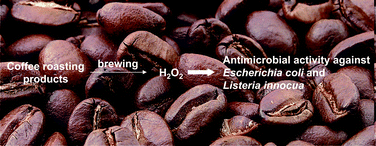Coffee shows distinct antimicrobial activity against several bacterial genera. The present study investigated molecular mechanisms and active ingredients mediating the antimicrobial effect of coffee. Depending on concentration, roasted, but not raw coffee brew inhibited the growth of Escherichia coli and Listeria innocua. Several coffee ingredients with known antibacterial properties were tested for their contribution to the observed effect. In natural concentration, caffeine, ferulic acid and a mixture of all test compounds showed very weak, but significant activity, whereas trigonelline, 5-(hydroxymethyl)furfural, chlorogenic acid, nicotinic acid, caffeic acid, and methylglyoxal were not active. Antimicrobial activity, however, was completely abolished by addition of catalase indicating that H2O2 is a major antimicrobial coffee component. In accordance with this assumption, bacterial counts during 16 h of incubation were inversely related to the H2O2 concentration in the incubation solution. Pure H2O2 showed slightly weaker activity. The H2O2 dependent antimicrobial activity of coffee could be mimicked by a reaction mixture of D-ribose and L-lysine (30 min 120 °C) indicating that H2O2 is generated in the coffee brew by Maillard reaction products. Identification of H2O2 as major antimicrobial coffee component is important to evaluate the application of coffee or coffee extracts as natural preservatives.

You have access to this article
 Please wait while we load your content...
Something went wrong. Try again?
Please wait while we load your content...
Something went wrong. Try again?


 Please wait while we load your content...
Please wait while we load your content...